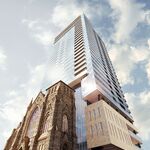First of all, you assume many people at CCTT travel to the subway, which is clearly not true at all.
Second of all, there are ALREADY many people travelling between Hurontario/Dundas and the CCTT. In fact, this is the busiest transit route in the city, not CCTT to Islington.
I am tellng you that nearly one-quarter of all Bloor-Danforth trips originates from Mississauga commuters funneling in. And during reverse peak in the PM this is overstated by the high volume of people that disembark at Islington/Kipling Stns. Only a third of this traffic is destined for inner-Etobicoke, the vast majority are heading towards 905 West.
I don't know why you seem pleased with the fact that Hurontario's overloaded with so much short-distance tripper traffic. That to me indicates extending the subway to CCTT is desperately needed to ALLEVIATE this congested stretch of Hwy 10, and thus free up seats on the LRT for long-haul commuters coming in from a far. Why do you think more people would prefer a 10 minute LRT trip from Dundas-Hurontario up to Robert Speck
then have to transfer inwards to CCTT when the subway can preform the same task directly in around 5 mins?
Frequency has nothing to do with it. People at Square One are not going to take route 1 instead just because it has higher frequency. That is just a ridiculous suggestion.
Sure they do. If people are on-board the 19 bus already and there's no 26/76 in sight, why would they bother to get off and wait? The poor scheduling of those route's are a testament to their lower usage. Besides, Dundas is a true crosstown corridor bringing in folks all the way from Ridgeway/South Commons/UTM, so of course there'll be more riders on-board.
Besides, the combined peak frequency of Dundas (4 to 6 minutes) was not much different from Burnhamthorpe (6 to 7 minutes).
During AM and PM peak hours (and even sometimes during mid-afternoon) it's commonplace to witness a 1 bus appear, then a minute or so later it's followed by a 201 or 1C. And because the area east of Cooksville is mixed commercial/industrial, the bus along Dundas makes less intermediate stops saving travel times.
I repeat: the 206 was by far the fastest AND most direct route to the subway from CCTT, and it had lower ridership than the 201.
And I just explained why.
Burnhamthorpe does not have higher population density than Dundas. Population density alone is not important anyways. Subways should be built in mixed-use areas, not residential areas.
That's why I voted for the RTES alignment. B'thrope requires too many mid-block stops to make such a routing speedy for long-haul commuters.
C'mon, first you say 80,000+, now you say only 40,000, a far cry from 80,000, isn't it. MT claims 20,000. I will believe MT.
80,000+ was the same as when you listed out the total numbers for the 19, 19A, 202, 201, 1, 1C, 26 and 206. I merely combined the total daily boardings for
all the MT routes that converge at CCTT, obviously. So for the routes that begin at CCTT we can assume nearly half of all riders start or end their trips along those perspective routes at CCTT. In other words:
half of 80,000. It may be marginally lower than that, but obviously the figure would remain substantially high if and when the subway connects there.
But it does not matter since the terminal is already at capacity, and the Transitway has not even been built yet! A subway connection here would just not be possible.
If CCTT isn't the epitome of a transit hub, then I don't know what is. In order for transit to be efficient and effective, systems and networks have to be as
interconnected as possible. Just think: people riding the Hurontario LRT will desire a subway connection. People from the 403 Transitway will desire a direct subway connection. People from GO Transit buses will desire a direct subway connection. People from western 'Sauga whose MT buses only connect as far east as CCTT will again desire a direct subway connection. Local patrons/condo dwellers/office workers/municipal servants will all desire a direct subway connection. There is literally a dozen reasons why to make this vital link.
And capacity concerns? What better way is there to alleviate CCTT then to alter the present-day landscape of it? Several routes would be relocated to new terminals in eastern Mississauga and surface feeders needed to get around MCC would see ridership dips as subway converts opt to walk to/from stations instead. This frees up CCTT for the long-haul commuters (those from Malton, the industrial NE, Erin Mills, Streetsville, Meadowvale, % of Brampton/Oakville riders) to have direct accessibility to the greater region, with one transfer-free ride into the 416.
Besides the mall, there is nothing within walking distance of the terminal except parking lots, Playdium, and a few big box stores.
Any subway to CCTT could easy well incorporate a Burnhamthrope Stn en route. Depending on where exactly we'd situate it, places like Kariya Gt/City Centre Dr (centric to a lot of office buildings) and Duke of York (Living Arts Ctr, City Hall, condominiums) would be easy walking distance for most pedestrians.
Anyway, I still don't understand why you'd terminate the subway at Hurontario-Dundas, missing even Cooksville GO, when the MCC subway would make a stop in the vicinity? Hence facilitating not only the direct Hurontario LRT interchange but also alleviating that corridor's transit congestion by taking CCTT/MCC bound passengers off the LRT line and onto the subway.




